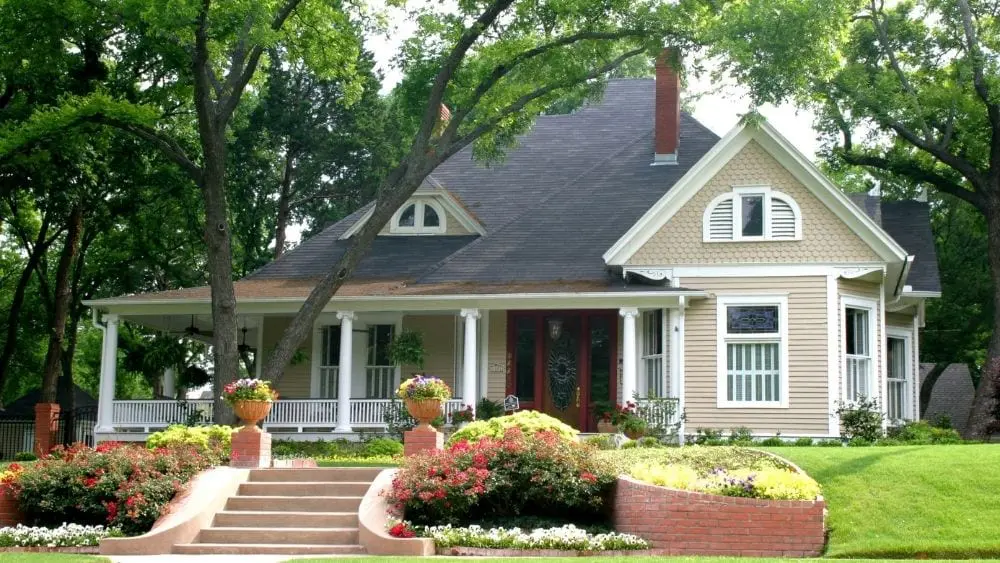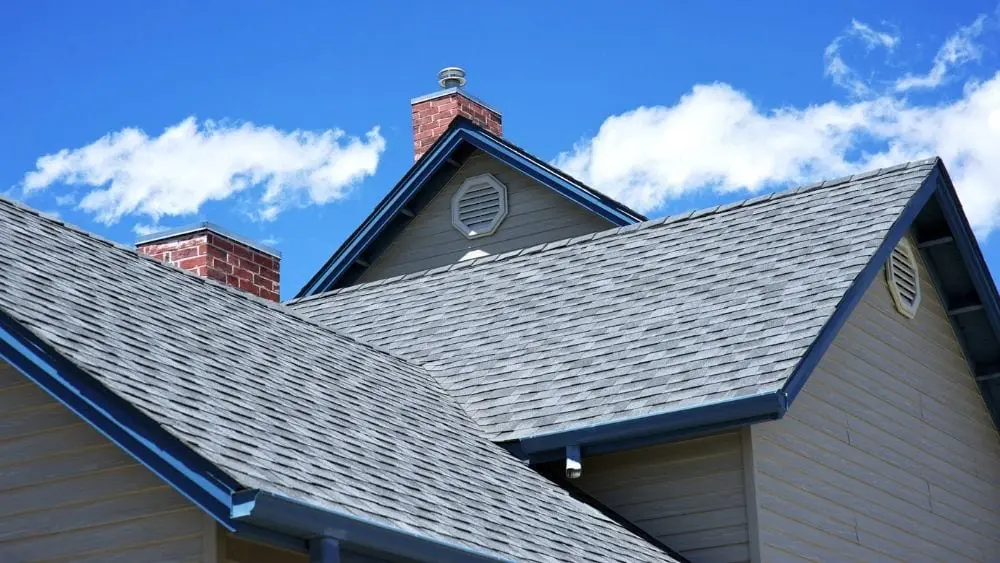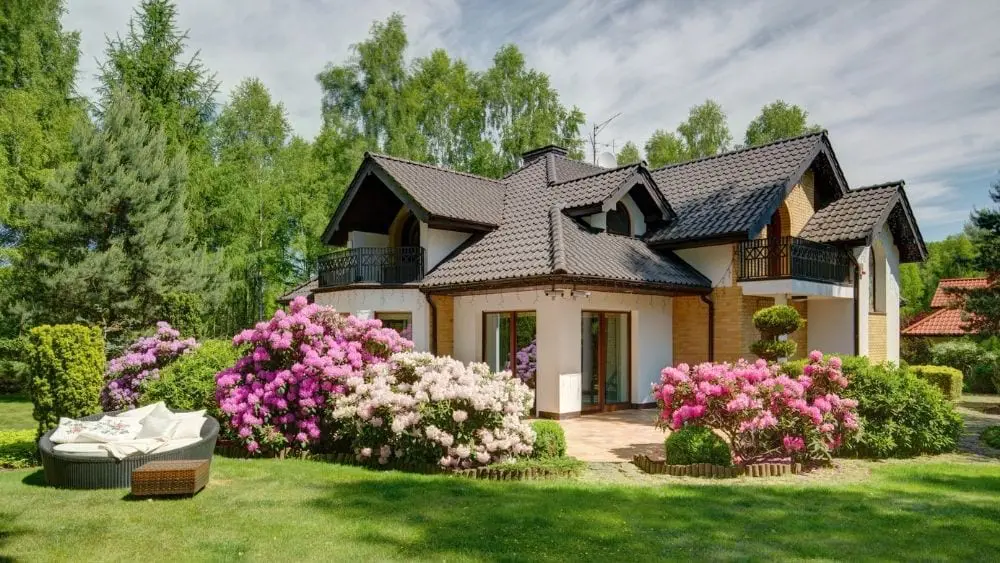
Ask a child to draw a house and the resulting image will likely include a square house with a triangle on top. That roof style is a gable roof, also known as a peaked or pitched roof. Gable roofs are among the most popular roof styles in the U.S. and have a familiar shape with sloping sides that form a triangle at the top known as a gable. Depending on their size and style, homes can include more than one gable.
The gable itself typically is built with materials used on the exterior of the house such as stone, siding or wood rather than roofing materials. Gable roofs tend to be found in colder climates such as New England and Canada because the steep slope allows rain and snow to slide off rather than accumulate on the top of the house.
Materials for Gable Roofs
Almost any type of roofing material can be used on a gable roof, such as asphalt shingles, cedar shakes, metal or tiles made of terra cotta, clay, or concrete.
- Asphalt is one of the most common materials used for a gable roof, especially if it has a dormer, hips and valleys, because it can reduce the chance of a leak. Asphalt shingles are weather-resistant and come in a variety of colors and styles.
- Metal roofs are resistant to extreme temperatures, wind, and hail. While metal roofs are more costly than asphalt shingle roofs, they are durable and require little maintenance.
- Tile roofs are also durable and can last 60 to 100 years. The material is weather resistant and easy to maintain, but the weight of the tiles means installation can be more complicated and therefore more expensive than asphalt shingles.
- Cedar shake, which is made of wood, is a popular option for gable roofs because it resists leaks around a dormer and other areas. While cedar shake roofs are attractive, they require more maintenance than some other materials and are vulnerable to water damage.
Many gables have varied roof heights with peaks and valleys and may include dormer windows. Your roofer may want to install metal shingles or a standing seam metal roof to prevent leaks. Flashing, which refers to thin pieces of metal used to prevent roof leaks, should be installed around the edges of the dormer, a chimney, windows, and gutters.

Pros & Cons of Gable Roofs
While this is a popular type of roofing style, a gable roof does come with it’s own set of pros and cons. Here are a few considerations for you to keep in mind to help you determine if this is the best type of roof for your home.
Climate Considerations
While gable roofs are popular, they’re not necessarily the perfect choice for every home or every climate. Gable roofs are not well-suited to locations with frequent high winds or that are prone to hurricanes. A gable roof can collapse if the frame lacks well-constructed support.
Their deep overhang can detach from the home in high winds or hurricane, which can also cause materials to peel off from the sloping sides of the roof. If you have a gable roof and a windstorm hits, it would be wise to have it inspected after the storm.
Architectural Challenges
Complex gable roofs can create architectural challenges for your builder because the interior walls must be different heights to match the shape of the roof. In some cases, particularly if you live in an area with high winds, extra support must be designed into the roof to prevent wind damage. Both issues can require additional time, which increases costs.
Simple gable roofs can be easier to build and therefore less expensive than more complex designs. The main benefit of gable roofs is their ability to resist snow and water accumulation. Leaves can also slide more easily off a gable roof than a flat roof.
Added Interior Space
A steeply pitched gable roof allows you to have vaulted ceilings and more attic space. You can add a gable vent so moisture can escape from the top of your home and to allow for extra ventilation for better indoor air quality.
Gable roofs complement a variety of architectural styles and can be ornamented with pediments and brackets to match modern aesthetics or a more ornate Victorian look.
Types of Gable Roofs
While a simple peaked roof with a triangular gable is what most people visualize when thinking of a gable roof, there are some variations that can be adapted to many home styles.
- Gable: A standard gable is a slanted or pitched roof that creates flat areas on the front, side or back of the house known as a gable. Homes can have multiple gables.
- Gable with Dormer: Many gable roofs include a dormer, which is a structure that protrudes from the flat wall of a house. Homes can have one or more dormers, often with a gabled roof of their own.
- Dutch Gable: A Dutch gable roof is a hybrid style that mixes a hip roof and a gable roof, typically with each sloping section broken into two sections for more interior space under the roof. This roof style is frequently used for barns.
- Open Gable: An open gable refers to the flat gable constructed of materials that match your home such as siding, stone, or wood.
- Box Gable: A box gable describes a gable that extends beyond the flat surface of the house and is enclosed.
- Front Gable: Colonial-style homes often have a gable roof above the front door with the flat gable serving as a pediment above the entrance.
- Side Gable: A side gable roof is one of the simplest configurations, with a pitched roof over two sides placed at an angle. The sides meet in the middle of the roof with the gable underneath.
- Crossed Gable: A crossed gable roof refers to a configuration when two gable roof sections are placed at right angles, such as a house with two wings. The crossed gable design can also be used above your house and garage.
- L-Shaped Gable: Gable roofs can be configured in a variety of forms. An L-shaped gable roof meets at right angles over two sections of a house, also known as a crossed gable.
- False-Front Gable: A false-front gable has gable fronts that are in place for aesthetic reasons over a low-pitched roof.

Architectural Styles That Feature Gable Roofs
Gable roofs are so popular that they can be found on homes of nearly every style. The configuration of the roof will vary according to the architecture of the home. Residential styles that frequently have a gable roof include:
- A-Frame: A-frame homes and Swiss chalets, often found in mountain communities, have a triangular shape with a steeply pitched gable roof designed to allow snow to slide to the ground. These homes typically have front and rear gables.
- Bungalow: Bungalows tend to be small homes with a low-pitched gable roof.
- Cape Cod: Cape Cod-style homes usually have a simple square or rectangular shape with one or two floors and a steeply pitched gable roof, often with dormers and shutters.
- Craftsman: Also known as Arts-and-Crafts-style homes, a Craftsman style house typically have an unornamented design with a front porch, overhanging eaves, and a low-pitched gable roof.
- Georgian: Georgian-style homes, named after King George, typically have a formal, symmetrical design with a side-gabled roof.
- Gothic Revival: These homes include steep roofs with crossed gables, Gothic-style windows with pointed arches and ornate trim on the gables, windows, and doors.
- Greek Revival: These classically designed homes typically have columns, rectangular windows, and a gable roof, particularly in the Midwest and Northeast where they have a front gable.
- Saltbox: Primarily seen in New England, these homes have a gable roof with a steep slope and one side shorter than the other. The home design resembles an old-fashioned box used to store salt and offers protection from salt damage from the sea.
- Tudor: Timbered exteriors on the upper floors and bay windows are a hallmark of a Tudor-style house, along with one or more steeply pitched crossed gables.
- Victorian: Both Queen Anne and Victorian-style houses often have a steeply pitched gable roof. Queen Anne homes include elaborate details include cross-gabled roofs, towers, chimneys, and porches. Gingerbread trim is often added to the gables. Stick homes are a little less elaborate but often have a steeply pitched gable roof with an overhang.
While gable roofs can be seen throughout the U.S., they’re more commonly found in snowy locations and less likely to appear in windy or hurricane-prone areas. Talk with your builder or architect to see if a gable roof matches your style, location, and budget.

Michele Lerner is an award-winning freelance writer, editor and author who has been writing about real estate, personal finance and business topics for more than two decades.
 How to Choose the Best Bedroom Ceiling
How to Choose the Best Bedroom Ceiling